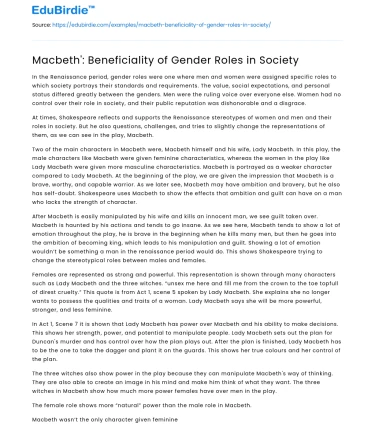In the Renaissance period, gender roles were one where men and women were assigned specific roles to which society portrays their standards and requirements. The value, social expectations, and personal status differed greatly between the genders. Men were the ruling voice over everyone else. Women had no control over their role in society, and their public reputation was dishonorable and a disgrace.
At times, Shakespeare reflects and supports the Renaissance stereotypes of women and men and their roles in society. But he also questions, challenges, and tries to slightly change the representations of them, as we can see in the play, Macbeth.
Save your time!
We can take care of your essay
- Proper editing and formatting
- Free revision, title page, and bibliography
- Flexible prices and money-back guarantee
Two of the main characters in Macbeth were, Macbeth himself and his wife, Lady Macbeth. In this play, the male characters like Macbeth were given feminine characteristics, whereas the women in the play like Lady Macbeth were given more masculine characteristics. Macbeth is portrayed as a weaker character compared to Lady Macbeth. At the beginning of the play, we are given the impression that Macbeth is a brave, worthy, and capable warrior. As we later see, Macbeth may have ambition and bravery, but he also has self-doubt. Shakespeare uses Macbeth to show the effects that ambition and guilt can have on a man who lacks the strength of character.
After Macbeth is easily manipulated by his wife and kills an innocent man, we see guilt taken over. Macbeth is haunted by his actions and tends to go insane. As we see here, Macbeth tends to show a lot of emotion throughout the play, he is brave in the beginning when he kills many men, but then he goes into the ambition of becoming king, which leads to his manipulation and guilt. Showing a lot of emotion wouldn’t be something a man in the renaissance period would do. This shows Shakespeare trying to change the stereotypical roles between males and females.
Females are represented as strong and powerful. This representation is shown through many characters such as Lady Macbeth and the three witches. “unsex me here and fill me from the crown to the toe topfull of direst cruelty.” This quote is from Act 1, scene 5 spoken by Lady Macbeth. She explains she no longer wants to possess the qualities and traits of a woman. Lady Macbeth says she will be more powerful, stronger, and less feminine.
In Act 1, Scene 7 it is shown that Lady Macbeth has power over Macbeth and his ability to make decisions. This shows her strength, power, and potential to manipulate people. Lady Macbeth sets out the plan for Duncan's murder and has control over how the plan plays out. After the plan is finished, Lady Macbeth has to be the one to take the dagger and plant it on the guards. This shows her true colours and her control of the plan.
The three witches also show power in the play because they can manipulate Macbeth's way of thinking. They are also able to create an image in his mind and make him think of what they want. The three witches in Macbeth show how much more power females have over men in the play.
The female role shows more “natural” power than the male role in Macbeth.
Macbeth wasn’t the only character given feminine characteristics; another prime example would be King Duncan. Men in the renaissance period were supposed to be strong and intelligent. They were supposed to be able to protect themselves and their families, but Duncan was given the opposite characteristics. Duncan was a very oblivious man, in act 1, scene 6 Duncan says, “This castle hath a pleasant seat; the air nimbly and sweetly recommends itself unto our gentle senses.” This is ironic because Duncan is saying how pleasant the castle is, meanwhile, his murder will be done inside.
Even though Duncan was oblivious he also could not protect himself or his family, which also shows how Shakespeare went against the stereotypes given in the renaissance period.
This proves that Shakespeare tried to change and question the gender and power of the roles of men and women; from the stereotypes of the renaissance period.
As we see with Shakespeare’s writing of the play Macbeth, he tried switching the reputation of the power and roles that men and women were given. Even if people in the renaissance period did not catch on or even continue the change. In today’s society male and female equality is a huge focus, and the perspective on the roles of each has been drastically changed compared to the renaissance period.






 Stuck on your essay?
Stuck on your essay?

